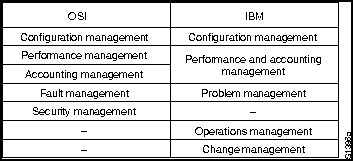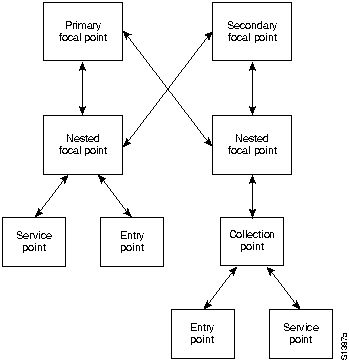|
|
IBM was one of the first companies to recognize the importance of a complete, integrated network management strategy. In 1986, IBM proposed Open Network Architecture (ONA), a framework describing a generalized network management architecture. NetView, the premier product for network management on an IBM mainframe, is actually a component of ONA. NetView provides a cohesive set of centralized network management services that allow users to monitor, control, and reconfigure their Systems Network Architecture (SNA) networks.
Since the introduction of ONA and NetView, IBM has almost continually enhanced, expanded, and otherwise altered its network management technology base. Today, IBM network management is comprehensive and extremely complex. This chapter describes the high-level basics of some of the components of IBM network management.
Functional Areas of Management
IBM divides network management into five user-based functions:
These network management functions do not correlate perfectly with those proposed by the International Organization for Standardization (ISO) in its Open System Interconnection (OSI) model. The OSI and the IBM network management functions are compared in Figure 33-1.
Figure 33-1 : OSI and IBM Network Management Functions

Configuration management controls information describing both physical and logical information systems resources and their relationships to each other. This information typically consists of resource names, addresses, locations, contacts, and telephone numbers. IBM's configuration management function corresponds very closely to OSI's concept of configuration management.
Through configuration management facilities, users can maintain an inventory of network resources. Configuration management helps ensure that network configuration changes can be reflected expeditiously and accurately in the configuration management database. Configuration management data is used by problem management systems to compare version differences and to locate, identify, and check the characteristics of network resources. Change management systems can use configuration management data to analyze the effect of changes and to schedule changes at times of minimal network impact.
An SNA management service called query product identification retrieves software and hardware physical information from the configuration management database. The information retrieved is sometimes called vital product data.
Performance and Accounting Management
This SNA management function provides information about the performance of network resources. Through analysis of performance and accounting management data, users can determine whether network performance goals are being met.
Performance and accounting management includes accounting, monitoring of response times, availability, utilization, and component delay, as well as performance tuning, tracking, and control. Data from each of these functions can result in the initiation of problem determination procedures if performance levels are not being met.
SNA management services define a problem as an error condition that causes a user to lose full functionality of a system resource. SNA divides problem management into several areas:
Operations management involves management of distributed network resources from a central site. It entails two sets of functions, common operations services and operations management services.
Common operations services allow management of resources not explicitly addressed by the other management categories of SNA by allowing specialized communication with these resources through new, more capable applications. Two very important services providing this capability are the execute command and the resource management service. The execute command provides a standardized means of executing a remote command. Resource management services provide a way to transport information in a context-independent manner.
Operations management services provide the ability to control remote resources through resource activation, resource deactivation, command cancellation, and the setting of network resource clocks. Operations management services can be initiated automatically as a result of system problem notification forwarding, thereby allowing automatic handling of remote problems.
Change management helps users control network or system changes by allowing the sending, retrieving, installing, and removing of change files at remote nodes. Further, change management allows node activation. Changes occur because either user requirements have changed or because a problem must be circumvented.
Although problems cause change, change can also cause problems. Change management attempts to minimize problems created by change through encouraging orderly change and by tracking changes.
Principal Management Architectures and Platforms
IBM offers several management architectures and many important management platforms.
Open Network Architecture Framework
The basic ONA framework is shown in Figure 33-2.

Focal points provide support for centralized network management operations. They are the management entities referred to in the general model described previously. Focal points respond to end station alerts, maintain management databases, and provide the user interface to the network management operator.
There are two kinds of focal points, primary and secondary. Primary focal points are as described previously. Secondary focal points provide backup for primary focal points and are used when primary focal points fail.
Nested focal points provide distributed management support for portions of large networks. They forward critical information to more global focal points.
Collection points relay information from self-contained SNA subnetworks to focal points. Collection points are commonly used to forward data from IBM peer-to-peer networks into the ONA hierarchy.
Entry points are SNA devices that can implement ONA for themselves and other devices. Most standard SNA devices are capable of being entry points.
Service points are systems that provide access into ONA for non-SNA devices. Service points are capable of sending network management information about non-SNA systems to focal points and are also capable of receiving commands from focal points, translating them into a format acceptable to non-SNA devices, and forwarding them to non-SNA devices for execution. Service points are essentially gateways into ONA.
IBM announced SystemView in 1990. SystemView is a blueprint for the creation of management applications capable of managing multivendor information systems. Specifically, SystemView describes how applications that manage heterogeneous networks will look, feel, and cooperate with other management systems. Officially, SystemView is the systems management strategy of Systems Application Architecture.
NetView is IBM's most comprehensive enterprise network management platform. It has the following major parts:
IBM's LAN Network Manager (LNM) product is an OS/2 Extended Edition-based network management application that enables control of Token Ring local-area networks (LANs) from a central support site. NetView can see LNM activity (for example, alarms). LNM communicates with LAN Station Manager (LSM) software, which implements management agents in individual LAN end stations. Communication between LNM and LSM is effected using OSI Common Management Information Services/Common Management Information Protocol (CMIS/CMIP) running over the connectionless Logical Link Control (LLC) protocol.
IBM has added support for the Simple Network Management Protocol (SNMP). For information about this protocol, see Chapter 32, "Simple Network Management Protocol."
|
|
Copyright 1988-1996 © Cisco Systems Inc.